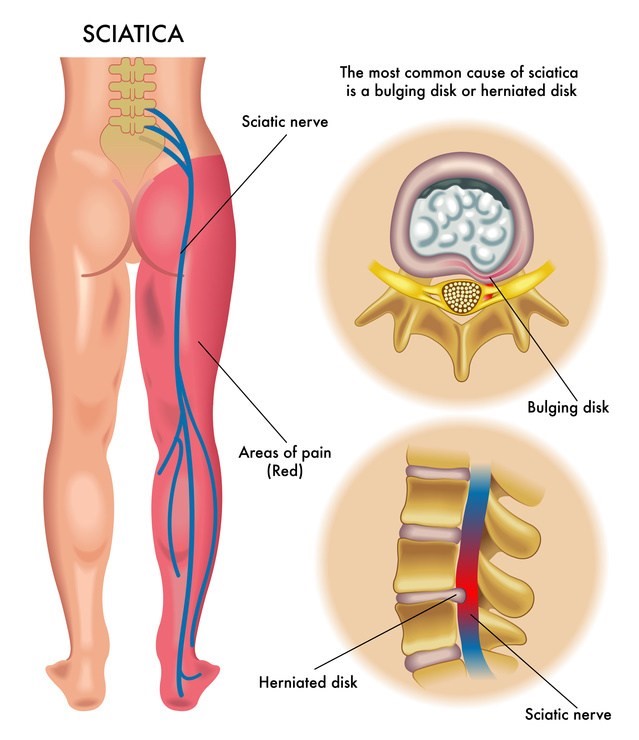Sciatic neuritis also known as Sciatica pain. It is a condition when the sciatic nerve gets irritated, pinched, inflamed or compressed causing pain travelling down from the buttock to the legs. Sciatic nerve is one of the largest nerve in the human body and is formed of five nerve roots from the spinal L4-S3 region. It travels deep in the buttock region and down the back of the thigh all the way to the heel and sole of the foot. The function of Sciatic nerve is to connect the vital spinal cord with the skin and muscles of the thigh, leg and foot. Sciatic Neuritis is a common condition that affects up to 40 percent of people at one point during their lifetime.
Sciatic nerve can get affected by multiple reasons. It may get irritated from herniated or degenerated lumbar disc, spinal stenosis, or spondylolisthesis. Occupational triggers for Sciatic neuritis may include prolonged sitting, rotation of the torso, prolonged inactivity and/or lifting heavy objects. There are a number of other risk factors that increase the risk of sciatic neuritis e.g. increase in age impacts the spinal conditions. Individuals over the age of 40 are at the higher risk of sciatica due to higher chances of herniated disc, bone spurs and degeneration. Slippage of one vertebra so that it is out of line with one above knows as Spondylolisthesis can also cause Sciatica pain. It narrows the opening through which nerve exits down the pelvis, which can ultimately compromise the sciatic nerve. A sudden trauma/ injury to the lumbar or sciatic nerve are another risk factor. Excessive overweight (obesity) increases the additional stress on the spine and can affect the lower spinal vertebra contributing to the risk of sciatic neuritis. Prolonged sedentary behavior, particularly sitting may lead to instability in the spine causing herniated spinal discs. Diabetes can also cause damage to the surroundings kidneys, including the sciatic nerve.
 Sciatica is also very common in pregnancy. The reason behind that certain hormones of pregnancy cause a loosening of their ligaments. Ligaments hold the vertebrae together, protects the spinal discs and stabilize the spine. Ligament laxity can cause the spine to become unstable and can cause disc to bulge or protrude. The baby’s weight and position can also add pressure to the sciatic nerve. Furthermore, history of Piriformis syndrome; a small muscle that lies deep down in the buttocks, becomes tight or spasms which can irritate the sciatic nerve.
Sciatica is also very common in pregnancy. The reason behind that certain hormones of pregnancy cause a loosening of their ligaments. Ligaments hold the vertebrae together, protects the spinal discs and stabilize the spine. Ligament laxity can cause the spine to become unstable and can cause disc to bulge or protrude. The baby’s weight and position can also add pressure to the sciatic nerve. Furthermore, history of Piriformis syndrome; a small muscle that lies deep down in the buttocks, becomes tight or spasms which can irritate the sciatic nerve.
The symptoms an individual usually experience is pain, tingling, numbness and/or weakness in lower back and travelling down to the leg. The specific symptoms of Sciatica involve weakness in the foot and pain along the back of the thigh. Usually the sciatic symptoms are affected on only one side of the body. The pain is usually sharp which gets worsened by prolonged sitting. The red flag symptoms and/or signs for Sciatica that require medical immediate attention includes bladder or bowel incontinence, pain in the groin and/or worsening of the leg pain.
To diagnose Sciatic neuritis, healthcare provider will review the medical history where they will ask about the symptoms. The physical examination will be performed which will check the flexibility and strength of the muscles. Spinal x-rays, MRI and/or CT scans can also be ordered to see detailed images of bone and soft tissues of the spine and surrounding segments. An MRI can show pressure on a nerve, disc herniation and any arthritic condition that might be pressing on a nerve.
To treat the sciatica, stretching and strengthening exercises for the lumbosacral spine helps to stable the spine and improve the spinal function. Using heat (if chronic) or Ice (if acute) also helps to reduce the sciatic nerve inflammation. Ensuring supportive and ergonomic chairs will reduce the chances of irritated/inflamed sciatic nerve. Massaging the affected area with an anti-inflammatory crème helps relieve sciatica pain and inflammation. Staying active and eating a healthy diet can help to reduce the symptoms. Chiropractic care also helps in the relief of the Sciatica pain. Chiropractor focus on locating, analysing and correcting spinal dysfunctional joints where there is joint misalignment. A misaligned spinal segment can also lead to impingement and/or irritation of the nerve which affects the joint overall. Chiropractors focus on the correction of the joint misalignment, which helps to remove the pressure forced upon the nerve roots. Through Chiropractic care, many patients experience reduction in nerve inflammation and compressing. It allows the body to regain a healthy back and lower extremities. Taking medicines to reduce pain, inflammation and swellings.
It may take up to six weeks of conservative care which involves ice, heat, stretching exercise, prescribed medication, acupuncture and/or chiropractic. If the condition is not relieved or leg pain starts to worse with severe weakness in the muscles of the lower extremities, surgery would be considered. The goal of spinal surgery for sciatic pain is to remove the pressure on the nerves that are being pinched and to make sure the spine is stable. Surgical options to relieve sciatica include Microdiscectomy (minimal invasive procedure to remove fragments of a herniated disk that are pressing on a nerve) and Laminectomy (the lamina of the vertebral bone that is causing pressure on the sciatic bone is removed). Complications that may associate with sciatica include permanent nerve damage, resulting in a loss of feeling in the affected legs.
There are some risk factors which cannot prevent the risk of Sciatic neuritis e.g. degenerative disc disease, sciatica due to pregnancy or accidental falls. However, there are possible factors that may help to protect the spine and reduce the risk. These include maintaining good posture while sitting, standing, lifting objects and sleeping helps relieve pressure on the spinal segment. Maintaining a healthy diet, exercising regularly keeps the joint flexible and strengthen the core muscles. These muscles work to support the spine well. Chiropractic care helps to correct the joint misalignments, strengthening the weakened muscles in the spine which will ultimately stabilise the spine. If you or anybody you know who is experiencing Sciatica, get in touch with your nearest Chiropractor and start your journey towards the healthy living.







